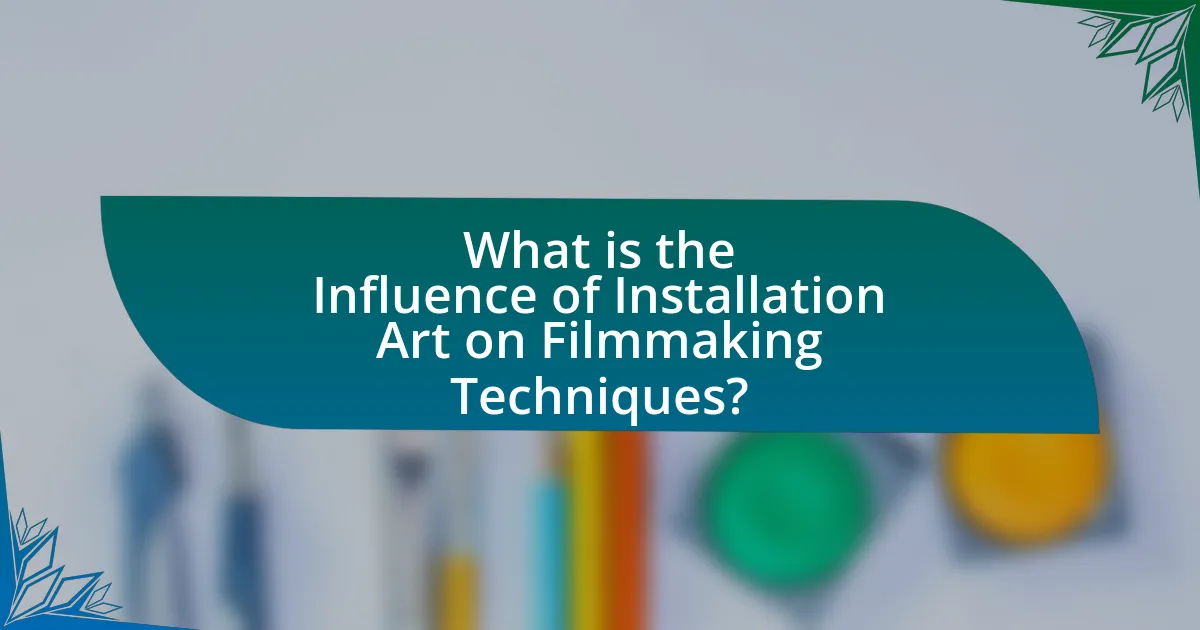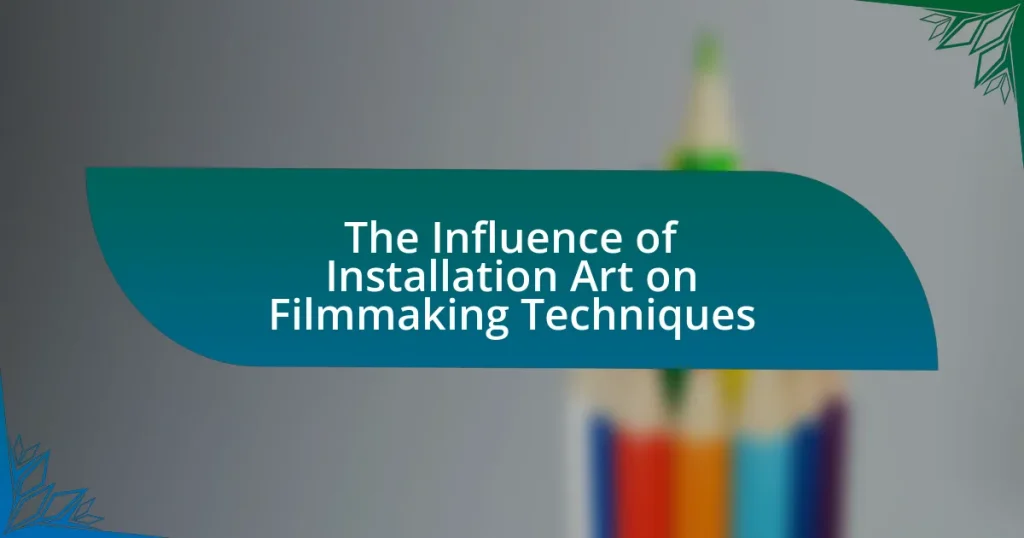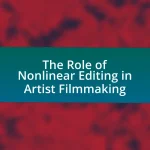The article examines the influence of installation art on filmmaking techniques, highlighting how immersive environments and non-linear narratives from installation art enhance viewer engagement in film. It traces the evolution of installation art from its early 20th-century origins to contemporary practices, emphasizing its characteristics such as spatial awareness and audience interaction. The article also discusses specific filmmaking techniques inspired by installation art, including immersive storytelling and sound design, and addresses the challenges filmmakers may face when integrating these elements into their work. Additionally, it offers practical tips for filmmakers to effectively blend installation art with cinematic techniques, ensuring a cohesive narrative while enhancing audience experience.

What is the Influence of Installation Art on Filmmaking Techniques?
Installation art significantly influences filmmaking techniques by introducing immersive environments and non-linear narratives. Filmmakers often adopt spatial awareness and audience interaction from installation art, creating films that engage viewers in a more participatory manner. For instance, the use of multi-screen installations in galleries has inspired filmmakers to experiment with fragmented storytelling and visual layering, as seen in works by directors like David Lynch and Chris Marker. This blending of mediums enhances the sensory experience of film, allowing for a more profound emotional connection with the audience.
How has installation art evolved over time?
Installation art has evolved significantly from its early 20th-century origins to contemporary practices. Initially, installation art emerged as a response to traditional art forms, with artists like Marcel Duchamp and his readymades challenging conventional aesthetics. Over time, the movement expanded in the 1960s and 1970s, with artists such as Yayoi Kusama and Robert Smithson creating immersive environments that engaged viewers physically and emotionally. The introduction of new technologies in the late 20th century, including video and digital media, further transformed installation art, allowing for interactive and multimedia experiences. Today, installation art often incorporates elements of performance and audience participation, reflecting broader cultural and social themes, as seen in the works of contemporary artists like Olafur Eliasson and Ai Weiwei. This evolution illustrates the dynamic nature of installation art and its ongoing dialogue with other artistic disciplines, including filmmaking.
What are the key characteristics of installation art?
Installation art is characterized by its immersive and experiential nature, often transforming a space into a specific environment that engages the viewer. This art form typically incorporates various materials, including sculpture, video, sound, and light, to create a multi-sensory experience. Additionally, installation art is site-specific, meaning it is designed for a particular location, enhancing the interaction between the artwork and its surroundings. The participatory aspect is also significant, as it invites viewers to engage actively with the work, often altering their perception of space and context. These characteristics distinguish installation art from traditional forms, emphasizing the relationship between the artwork, the viewer, and the environment.
How do these characteristics relate to filmmaking?
The characteristics of installation art significantly influence filmmaking techniques by introducing immersive environments and multi-sensory experiences. Filmmakers often adopt spatial awareness and audience engagement strategies from installation art to create more dynamic narratives and visual storytelling. For instance, the use of unconventional spaces in installation art encourages filmmakers to explore non-linear storytelling and innovative cinematography, as seen in films like “Enter the Void,” which employs a first-person perspective to enhance viewer immersion. This blending of art forms enriches the cinematic experience, making it more interactive and reflective of contemporary artistic practices.
Why is the intersection of installation art and filmmaking significant?
The intersection of installation art and filmmaking is significant because it creates immersive experiences that engage audiences in unique ways. Installation art often utilizes space, materials, and sensory elements to evoke emotional responses, which filmmakers can incorporate to enhance storytelling. For example, artists like Olafur Eliasson and Pipilotti Rist have influenced cinematic techniques by integrating environmental elements and interactive components, leading to films that challenge traditional narrative structures. This blending of mediums fosters innovation in visual language and audience interaction, as seen in works like “The Clock” by Christian Marclay, which merges time-based art with cinematic storytelling, demonstrating the potential for cross-disciplinary collaboration to redefine viewer engagement.
What unique perspectives does installation art bring to film?
Installation art brings a spatial and immersive perspective to film, enhancing viewer engagement through multi-sensory experiences. This art form encourages filmmakers to explore non-linear narratives and interactive elements, allowing audiences to become active participants rather than passive viewers. For instance, works like Olafur Eliasson’s “The Weather Project” have influenced filmmakers to incorporate environmental elements that evoke emotional responses, demonstrating how physical space can shape storytelling. Additionally, installation art often blurs the boundaries between different media, prompting filmmakers to experiment with visual and auditory techniques that challenge traditional cinematic conventions.
How can installation art challenge traditional filmmaking narratives?
Installation art can challenge traditional filmmaking narratives by creating immersive environments that prioritize audience interaction over linear storytelling. Unlike conventional films that follow a predetermined sequence, installation art allows viewers to engage with the artwork from multiple perspectives, fostering a non-linear experience. This approach disrupts the passive consumption typical of traditional cinema, as audiences actively navigate the space and interpret the narrative in a personalized manner. For instance, artists like Olafur Eliasson and Yayoi Kusama utilize spatial dynamics and sensory elements to evoke emotional responses, thereby redefining narrative structures. This shift emphasizes the role of the viewer as a co-creator of meaning, contrasting sharply with the authorial control exercised in traditional filmmaking.

What are the specific techniques in filmmaking influenced by installation art?
Specific techniques in filmmaking influenced by installation art include immersive storytelling, non-linear narratives, and the use of space as a narrative element. Immersive storytelling engages viewers in a multi-sensory experience, often utilizing surround sound and visual projections to create an environment that envelops the audience. Non-linear narratives, which are common in installation art, allow filmmakers to present stories in fragmented or disjointed ways, challenging traditional storytelling structures. Additionally, the use of space as a narrative element emphasizes the physical environment in which the film is experienced, often blurring the lines between the viewer and the artwork. These techniques reflect the principles of installation art, which prioritize viewer interaction and experiential engagement.
How does installation art impact visual storytelling in film?
Installation art significantly impacts visual storytelling in film by introducing immersive environments that enhance narrative depth. This form of art encourages filmmakers to explore spatial relationships and viewer engagement, allowing audiences to experience stories in a more visceral manner. For instance, films like “The Fall” by Tarsem Singh utilize elaborate set designs reminiscent of installation art, creating a visual tapestry that complements the narrative and evokes emotional responses. The integration of installation art principles, such as non-linear storytelling and interactive elements, can transform traditional cinematic techniques, making the viewing experience more dynamic and participatory.
What visual techniques are borrowed from installation art?
Visual techniques borrowed from installation art include immersive environments, spatial arrangement, and multi-sensory experiences. Immersive environments engage viewers by creating a sense of presence within the artwork, often utilizing large-scale installations that envelop the audience. Spatial arrangement emphasizes the relationship between objects and the viewer’s movement through space, influencing how narratives are perceived. Multi-sensory experiences incorporate sound, light, and tactile elements, enhancing emotional engagement and creating a more profound impact on the audience. These techniques have been effectively utilized in filmmaking to create more engaging and dynamic storytelling experiences.
How do these techniques enhance audience engagement?
Techniques derived from installation art enhance audience engagement by creating immersive experiences that captivate viewers’ attention. These techniques often involve multi-sensory elements, such as sound, light, and spatial design, which stimulate emotional responses and foster a deeper connection to the narrative. For instance, studies have shown that immersive environments can increase viewer retention and emotional involvement, as evidenced by research conducted by the University of Southern California, which found that participants in immersive installations reported higher levels of engagement compared to traditional viewing methods. This heightened engagement leads to a more memorable and impactful experience, ultimately enriching the audience’s interaction with the film.
In what ways does installation art influence sound design in film?
Installation art influences sound design in film by emphasizing spatial awareness and immersive experiences. This art form often utilizes sound as a key component to create an environment that engages the audience’s senses, which filmmakers adopt to enhance narrative depth. For instance, the use of ambient soundscapes in installation art can inspire filmmakers to incorporate similar techniques, allowing sound to shape the emotional landscape of a scene. Additionally, the interactive nature of installation art encourages filmmakers to explore non-linear sound design, where sound elements can change based on viewer interaction, mirroring the dynamic auditory experiences found in contemporary installations. This approach has been validated by various filmmakers who cite installation art as a significant influence on their sound design choices, demonstrating its impact on creating a more immersive cinematic experience.
What sound techniques are inspired by installation art?
Sound techniques inspired by installation art include immersive audio environments, spatial sound design, and site-specific soundscapes. Immersive audio environments utilize multi-channel sound systems to create a surrounding auditory experience, often enhancing the viewer’s emotional response, as seen in works by artists like Janet Cardiff. Spatial sound design involves manipulating sound placement and movement within a space, allowing for a dynamic interaction between the audience and the sound, which is evident in installations by artists such as Ryoji Ikeda. Site-specific soundscapes are tailored to the unique characteristics of a location, integrating environmental sounds with artistic intent, a technique frequently employed in installations by artists like Max Neuhaus. These techniques demonstrate how installation art influences the auditory aspects of filmmaking, enriching narrative and emotional depth.
How does sound design contribute to the immersive experience?
Sound design significantly enhances the immersive experience by creating a multi-sensory environment that engages the audience on emotional and psychological levels. It achieves this through the use of spatial audio, which allows sounds to be perceived as coming from specific directions, thereby simulating a realistic setting. For instance, in films like “Dunkirk,” sound design plays a crucial role in conveying tension and urgency, as the auditory elements are meticulously crafted to reflect the chaos of war, immersing viewers in the narrative. Additionally, research by the University of Southern California highlights that well-executed sound design can increase audience engagement by up to 50%, demonstrating its effectiveness in enhancing the overall experience.

How can filmmakers effectively incorporate installation art elements into their work?
Filmmakers can effectively incorporate installation art elements into their work by integrating immersive environments that engage the audience’s senses and emotions. This can be achieved through the use of spatial design, interactive components, and multi-sensory experiences that blur the boundaries between film and physical space. For instance, filmmakers can create set designs that mimic installation art, allowing viewers to experience the narrative within a curated space, similar to how installation art invites interaction and contemplation. The use of technology, such as projection mapping or augmented reality, can further enhance this integration by transforming physical spaces into dynamic storytelling platforms. This approach has been validated by projects like “The Obliteration Room” by Yayoi Kusama, which demonstrates how immersive environments can evoke emotional responses and deepen audience engagement.
What are the best practices for blending installation art with film techniques?
The best practices for blending installation art with film techniques include creating immersive environments that engage the audience, utilizing spatial dynamics to enhance storytelling, and integrating multimedia elements to enrich the narrative. Immersive environments can be achieved by designing spaces that allow viewers to interact with both the installation and the film, fostering a deeper connection to the content. Spatial dynamics, such as the arrangement of visual and auditory components, can guide the viewer’s experience and influence their emotional response. Additionally, incorporating multimedia elements, such as projections or soundscapes, can create a layered experience that enhances the overall impact of the work. These practices are supported by examples like the work of artists such as Pipilotti Rist, who effectively combines video and installation to create engaging, multisensory experiences.
How can filmmakers maintain a cohesive narrative while using installation art?
Filmmakers can maintain a cohesive narrative while using installation art by integrating thematic elements and visual motifs that resonate throughout the film. This approach ensures that the installation art serves not only as a backdrop but also as a narrative device that enhances the story. For instance, filmmakers can use specific colors, shapes, or symbols in the installation art that reflect the emotional journey of the characters, thereby creating a visual language that supports the narrative arc. Research indicates that cohesive visual storytelling can significantly enhance audience engagement and comprehension, as seen in films like “The Fall” directed by Tarsem Singh, where the use of striking visual installations complements the narrative structure.
What tools and resources are available for filmmakers exploring installation art?
Filmmakers exploring installation art can utilize a variety of tools and resources, including software for 3D modeling and animation, video editing programs, and immersive technologies like virtual reality (VR) and augmented reality (AR). Software such as Adobe After Effects and Blender allows for the creation of dynamic visual elements that can enhance installation experiences. Additionally, platforms like Unity and Unreal Engine provide environments for interactive installations, enabling filmmakers to create engaging narratives that blend film and installation art. Resources such as workshops, online courses, and art grants from organizations like the National Endowment for the Arts support filmmakers in developing their projects, while exhibitions and festivals focused on installation art offer networking opportunities and exposure to innovative practices.
What challenges might filmmakers face when integrating installation art?
Filmmakers may face several challenges when integrating installation art, primarily related to spatial constraints and audience interaction. The unique nature of installation art often requires specific physical spaces that may not align with traditional filmmaking environments, complicating logistics and production design. Additionally, installation art frequently emphasizes viewer participation, which can disrupt conventional narrative structures and pacing in film, making it difficult to maintain audience engagement. Furthermore, the integration of multimedia elements from installation art can lead to technical difficulties, such as synchronization issues between visual and auditory components, which can detract from the overall cinematic experience.
How can filmmakers overcome these challenges?
Filmmakers can overcome challenges posed by the influence of installation art on filmmaking techniques by integrating immersive storytelling methods and utilizing innovative visual aesthetics. By adopting techniques such as interactive narratives and multi-sensory experiences, filmmakers can create a more engaging viewer experience that reflects the principles of installation art. For instance, the use of non-linear storytelling, as seen in films like “Eternal Sunshine of the Spotless Mind,” allows for a more dynamic exploration of themes, similar to how installation art invites viewers to interact with the space. Additionally, filmmakers can collaborate with installation artists to incorporate unique spatial designs and audience participation elements, enhancing the overall impact of their films. This approach not only broadens the creative possibilities but also aligns with contemporary audience expectations for immersive experiences.
What common pitfalls should filmmakers avoid?
Filmmakers should avoid common pitfalls such as neglecting pre-production planning, underestimating budget constraints, and failing to communicate effectively with the crew. Neglecting pre-production can lead to disorganized shoots and missed opportunities for creative input, as evidenced by numerous case studies where lack of preparation resulted in extended shooting schedules and increased costs. Underestimating budget constraints often leads to financial overruns, which can jeopardize the entire project, as seen in reports from the Producers Guild of America indicating that over 70% of independent films exceed their initial budgets. Lastly, ineffective communication can create confusion and misalignment among team members, which is supported by research from the American Film Institute showing that clear communication significantly enhances project outcomes.
What practical tips can filmmakers use to enhance their projects with installation art?
Filmmakers can enhance their projects with installation art by integrating immersive environments that engage the audience on multiple sensory levels. This can be achieved by designing sets that reflect the themes of the film, using mixed media elements such as projections, sculptures, and interactive components to create a more dynamic viewing experience. For instance, the use of large-scale installations can transform traditional film spaces into experiential art, as seen in works like “The Obliteration Room” by Yayoi Kusama, which invites audience participation and alters the perception of space. Additionally, collaborating with installation artists can bring fresh perspectives and innovative techniques to the filmmaking process, as demonstrated by the partnership between filmmaker Doug Aitken and installation artist Olafur Eliasson in projects that blur the lines between film and visual art.


